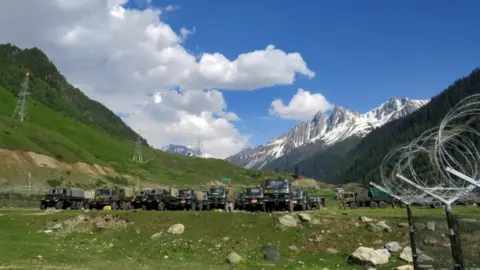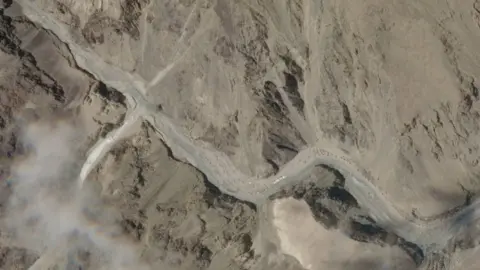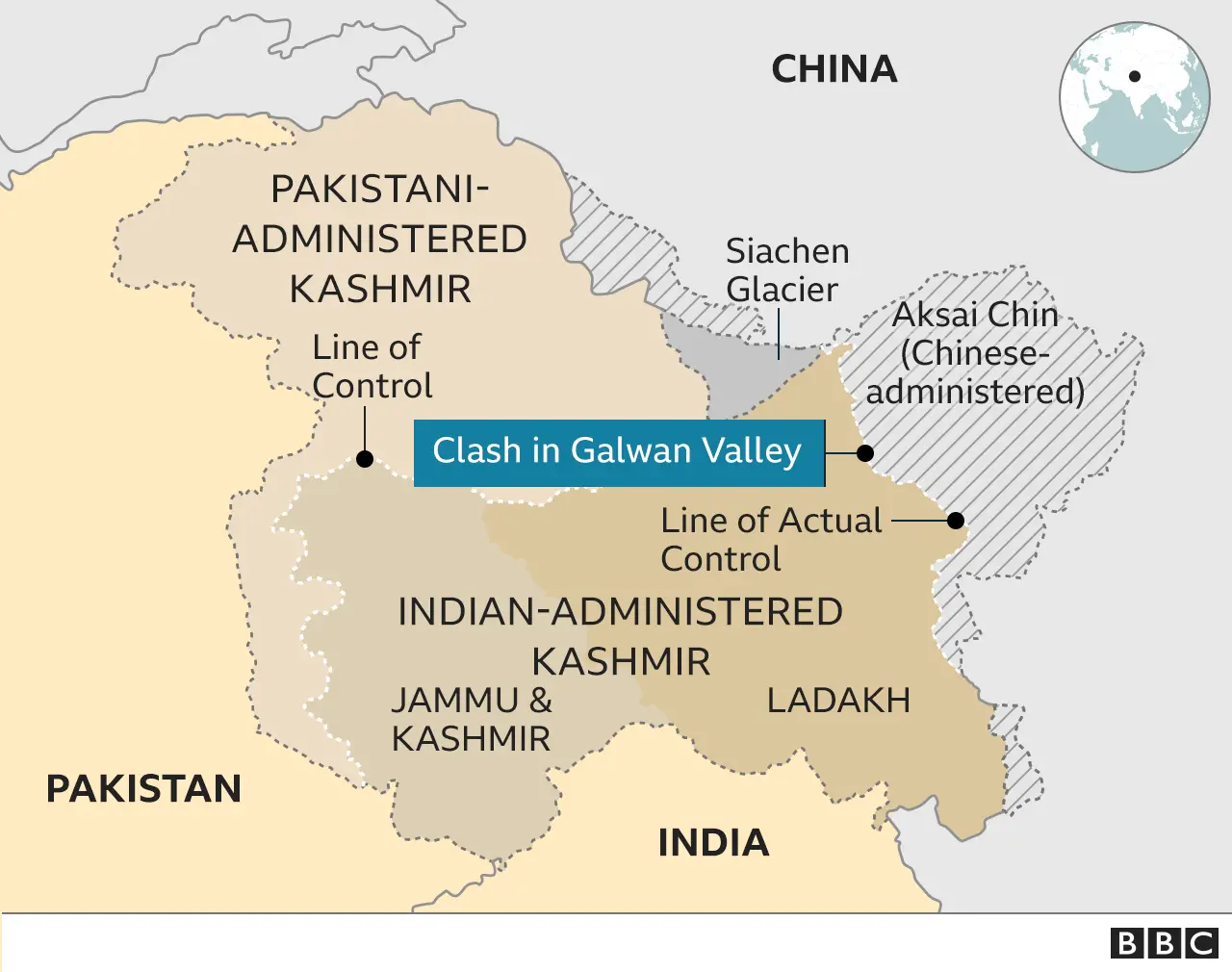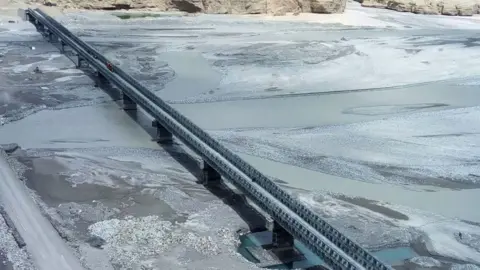India-China clash: Diplomats 'strongly protest' over border clashes
 Reuters
ReutersThe Indian and Chinese foreign ministers have exchanged protests over clashes in a disputed Himalayan border area which led to the deaths of at least 20 Indian troops.
India's Subrahmanyam Jaishankar said China tried to erect a structure inside Indian territory, while China's Wang Yi said Indian troops attacked first.
But in a phone call both men promised not to escalate the situation.
It was the first deadly clash at the disputed border for at least 45 years.
Soldiers reportedly brawled with sticks and bats but no shots were fired.
China has not released casualty figures. Unconfirmed reports in Indian media say at least 40 Chinese soldiers died. Some Indian soldiers are still believed to be missing.
Earlier Indian Prime Minister Narendra Modi said the Indian deaths "will not be in vain" and that India would be "proud that our soldiers died fighting the Chinese" in the clash in the Ladakh region on Monday.
Addressing the confrontation for the first time in a televised address on Wednesday, he said: "India wants peace but when provoked, India is capable of giving a fitting reply, be it any kind of situation."
What did the two diplomats say?
An Indian government statement following the phone conversation said that Chinese troops had tried to put up a structure on the Indian side of the de facto border, the Line of Actual Control (LAC), in the strategically important Galwan Valley.
It described this as "premeditated and planned action that was directly responsible for the resulting violence and casualties" and urged China to "take corrective steps".


The statement concluded that neither side would take action to escalate matters.
Meanwhile a Chinese statement quoted Mr Wang as saying: "China again expresses strong protest to India and demands the Indian side launches a thorough investigation... and stop all provocative actions to ensure the same things do not happen again."
"Both sides should resolve the dispute through dialogue, and keep the border safe and tranquil," he added.
What happened?
The fighting occurred in the precipitous, rocky terrain of the Galwan Valley.
Indian media say soldiers engaged in direct hand-to-hand combat, with some "beaten to death". During the fight, one newspaper reported, others fell or were pushed into a river.
 Reuters
ReutersThe Indian army initially said a colonel and two soldiers had died. It later said that "17 Indian troops who were critically injured in the line of duty" had died from their injuries, taking the "total that were killed in action to 20".
"I understand that some [further] Indian soldiers went missing. The Indian side is still working to release them from Chinese custody," defence analyst Ajai Shukla told the BBC.
Indian forces appear to have been massively outnumbered by Chinese troops.
A senior Indian military official told the BBC there were 55 Indians versus 300 Chinese, who he described as "the Death Squad".
"They hit our boys on the head with metal batons wrapped in barbed wire. Our boys fought with bare hands," the officer, who did not want to be named, said.
His account, which could not be verified, tallies with other reports in the Indian media detailing the savagery of the combat.
The clash has provoked protests in India, with people burning Chinese flags.
China has not confirmed how many of its personnel died or were injured. The BBC's Robin Brant in Beijing says that China has never given contemporaneous confirmation on military deaths outside of peacekeeping duties.
Our correspondent adds that on this occasion China's propagandists may not want to fan nationalist flames at home by making much of any loss, or admit to a significant and demoralising loss.
This is not the first time the two nuclear-armed neighbours have fought without conventional firearms on the border. India and China have a history of face-offs and overlapping territorial claims along the more than 3,440km (2,100 mile), poorly drawn LAC separating the two sides.

India shows restraint
Analysis by Geeta Pandey, BBC News, Delhi
The first comments from the Indian government on the violent standoff on the Chinese border came nearly 24 hours after the news broke on Tuesday.
And Prime Minister Narendra Modi and his cabinet colleagues - the defence minister and the home minister - have chosen their words carefully.
Usually boastful and given to grandstanding, Mr Modi and his ministers have displayed utmost restraint in their public messages this time, mostly sticking to mourning the loss of soldiers.
The prime minister did say: "India wants peace but, if instigated, it is capable of giving a befitting reply." But this is seen as aimed more at his political rivals and supporters domestically, rather than as a warning to Beijing.
China is not Pakistan and memories of the humiliating defeat in the 1962 war are all too real for any misadventure.

How tense is the area?
The LAC is poorly demarcated. The presence of rivers, lakes and snowcaps means the line can shift. The soldiers either side - representing two of the world's largest armies - come face-to-face at many points.
Border patrols have often bumped into each other, resulting in occasional scuffles.
The last firing on the border happened in 1975 when four Indian soldiers were killed in a remote pass in the north-eastern state of Arunachal Pradesh. The clash was variously described by former diplomats as an ambush and an accident.
But no bullets have been fired since.
At the root of this is a 1996 bilateral agreement that says "neither side shall open fire... conduct blast operations or hunt with guns or explosives within two kilometres of the Line of Actual Control".


But there have been tense confrontations along the border in recent weeks. In May Indian and Chinese soldiers exchanged physical blows on the border at Pangong Lake, also in Ladakh, and in the north-eastern Indian state of Sikkim hundreds of miles to the east.
India has accused China of sending thousands of troops into Ladakh's Galwan Valley and says China occupies 38,000 sq km (14,700 sq miles) of its territory. Several rounds of talks in the last three decades have failed to resolve the boundary disputes.
The two countries have fought only one war, in 1962, when India suffered a humiliating defeat.
There are several reasons why tensions are rising again now - but competing strategic goals lie at the root.
The two countries have devoted extensive money and manpower to building roads, bridges, rail links and air fields along the disputed border.
 Press Information Bureau
Press Information BureauBoth India and China see each other's construction efforts as calculated moves to gain a tactical advantage, and tensions often flare up when either announces a major project.
India also disputes part of Kashmir - an ethnically diverse Himalayan region covering about 140,000 sq km - with Pakistan.
